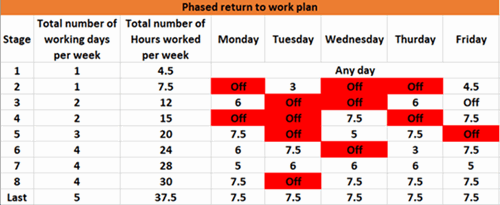Inevitably, members of staff will have time off sick. This can vary over periods of time, which can severely hinder the productivity of not only that employee’s workflow but other team members.
Therefore, it is essential for a robust policy to be in place to follow when they are returning to work after a sick day or period to allow them to start back strongly.
There are steps you should take whenever an employee returns from a period of sickness absence. Following these steps will ensure that you are supporting your employees while protecting your business.
Remember to download our return to work interview form template below, and use it to streamline the process. Call us for expert HR advice on sickness leave management, on 01455 858 132.

What is a return to work interview?
It’s a 1-to-1 meeting with an employee following an absence. There are multiple aims of this interview. These are:
- To send a clear message that absence is being managed and monitored. Asking an employee to explain their absence face to face deters dishonesty and unnecessary absence.
- To collect data around absences to help spot trends and implement absence management methods.
- In cases of long-term or serious absences, to plan a phased return to work and assess if there are any reasonable adjustments you can make to assist.
When should a return to work-interview be done?
If you are serious about implementing this as an absence management policy, then you should conduct one of these interviews after every absence.
Is there a back-to-work interview time scale? Not necessarily. For maximum effectiveness, you should conduct the interview as soon as possible. Ideally, on the day the employee returns to work, you can’t always manage this.
The interview shouldn’t take up a huge amount of time. 10-30 minutes is standard.
the importance of a good return to work policy?
People can find it hard to return to work after extended periods of absence, which can lead to reluctance to come in after long-term sickness even if they are able to work or reduced productivity when they do return.
Having a policy in place allows both the employer and the employee to feel comfortable with their return.
conducting a back-to-work interview after sickness absence
The majority of interviews you conduct will be following a sickness absence. If possible, the employee’s line manager should be the one to do this, but if not, you can get an HR representative or other senior manager to conduct the meeting.
Medical information is confidential and sensitive, so keep any notes in a safe and secure place, whether they’re written or digital.
You should conduct the interview sympathetically. Don’t pressure employees into revealing anything they’re uncomfortable with—they don’t have an obligation to reveal details of an existing condition or disability if they don’t want to.
One way to keep the interview on track and avoid any awkwardness is to follow the same format in a standardised form. We’ll look more at what you should include on the form a little later.

Return to work after sickness and employment law
While there are business reasons for you to have policy in place, there are also legal ones. There are several employment laws on when employees return to work after sickness, including:
- Equality Act 2010
- The Employment Rights Act
- The Health & Safety at Work etc Act
These laws dictate the procedure you should follow. They also tell you that you need to have policies and procedures on managing sick leave. If you haven’t got these already, you need to develop them in consultation with your staff or their representatives.
Return to work after sickness law also dictates several other obligations, these include:
- Training managers on sick leave and return to work
- Keeping in contact with workers who are off sick
- Having to consider workplace adjustments to help workers return to work
- Get professional advice on issues such as fitness to work
Phased return to work after sickness absence
One way to handle an employee returning to work after being sick is to allow a phased return.
This can take many forms, including:
- A shorter working day
- Working fewer days per week
- A reduced workload
You should discuss the terms of this with the individual to ensure it’s fair for all involved. Under no circumstances should you try to enforce a phased return to work plan without the employee’s consent.
Before returning to work after sick leave, inform the employee about any updates within the company policy. This way, the individual will be better prepared for the return. Agree the days/hours the employee will work when they return. Agree on any reasonable adjustments you intend to make before they return.
When they do return, schedule a weekly catch up to check-in and address any issues they’re having.
Can you conduct a back to work interview after 1 day of absence?
Technically, yes.
Although we recommend it, you can decide whether you want to conduct a return of an interview after every absence. If you do, ensure it isn’t critical or confrontational.
Remember, the objective of informal conversation is to reassure both the line manager and employee that you consider their absence to be genuine, ensure it’s properly documented, and highlight any underlying issues.
Following the interview, you might have to consider making reasonable adjustments. This is the perfect time to discuss these with your employee.
single day absences
So far, we’ve looked exclusively at long periods of absences—but what about the short-term, or employees returning to work after one sick day?
Holding a return to work interview after a short-term absence is still a good idea. It will show the employee that you take their wellbeing seriously and are tracking each absence.
One of the things to be on the lookout for is whether there are multiple instances of short-term absence. There is a way of measuring attendance records whether this will have a detrimental impact on your business—The Bradford Score.
You calculate this score by squaring the number of instances of absence and multiplying it by the total number of days absent.
For example, an employee with three instances of absence, of 3, 5, and 2 days would have a Bradford Score of (3 x 3) x 10 = 90. Any score over 200 indicates serious concerns. If you track employee absence this way, you can discuss it with an employee before it escalates to a disciplinary issue.
Conducting a return to work interview after maternity leave
In this case, it’d have different objectives. Firstly, it acts as a catch-up, ensuring the employee is aware of any significant changes to the business that took place during their absence.
Next, you’d want to assess any risks the new mother might face. Some of the most common risks new mothers face are:
- Exposure to infectious diseases.
- Work-related stress.
- Inadequate workstations and bad posture.
- Standing or sitting for large lengths of time.
In cases where the staff member’s job is no longer there for them when they return to work, you can discuss reallocating work or restoring the old job. To do this you must offer them a suitable alternative job, on terms & conditions no less favourable than the terms that applied before she was on maternity leave.
Finally, a new mother might want to change or reduce their workload. This is the time to discuss any requests for more flexible working hours, or part-time working.
It’s good business practice to set an agenda for the meeting prior to having it, as well as informing the employee of it too. This ensures they understand what you intend to discuss and can prepare in advance.

What is a phased return to work?
It’s the term used to detail the process of easing an employee back into work after a long period of absence due to ill health.
But what’s considered a ‘long-term absence’? According to the government, you may consider an absence long-term when the employee is off work for more than four weeks.
A phased return to work involves an arrangement between you and your employee. It allows them to come back to work on one or all of the following conditions:
- Reduced hours.
- Lighter duties.
- Different duties.
It could be after a serious injury or operation or a phased return to work after stress, anxiety or depression. Most times, employees can return to work with care and consideration.
However, when they leave mental health issues to fester, it can develop into other underlying conditions leading to longer periods of absence from work.
Whatever the case may be, it’s important to have policies addressing absences and the return to work process.
So why carry out a phased return to work after sickness? It has many benefits for you and your staff. In terms of expenses, it’s cheaper to support a returning employee than to recruit and train a new one.
It also encourages loyalty and increases morale and retention as employees who feel valued are less likely to leave your organisation.
Phased return to work pay
While employees are off work sick, they’re entitled to Statutory Sick Pay (SSP) if they qualify for it.
Upon their return to work, pay depends on the arrangement made. If they return to work but on reduced hours, they should get their normal rate of pay for the hours worked.
However, if they’re taking on lighter duties then it’s up to you and your employee to agree on a rate of pay. It’s a good idea to put any agreement in writing to avoid confusion down the line.
The same applies to a phased return to work holiday entitlement. No matter how long they’re off, their statutory holiday entitlement builds up while they’re off sick. If they’re not entitled to sick pay, they can ask to use their paid holiday instead of unpaid sick leave.
It’s worth noting, you can’t force them to use their annual leave if they’re eligible for sick leave.
Phased return to work examples
Although not a full legal requirement or obligation, it’s good business and best practice, to have a plan to support employees when they return to work. The plan may vary depending on the reason for the employee’s absence.
If an employee’s absence was due to stress or depression, in some cases, returning to work can play an important role on their road to recovery.
As well as providing them with a positive experience and a support network, it also contributes to regaining self-confidence and getting back into some sort of routine.
For example, if it’s a phased return to work after depression or other mental health conditions, the plan should consider triggers within the workplace and take steps to minimise them.
You can base your phased return to work plan on the example below:

How long should a phased return to work be?
There’s no set duration as to how long this period lasts. The phased return process may vary depending on the specific circumstance.
For example, if it’s a phased return to work after maternity leave, the employee may request:
- To come into work for three days a week instead of five
- Or to start work an hour later and finish an hour earlier.
The reason could span from anything from weaning the child off breast milk to adjusting to being away from them for extended periods.
Whatever the situation, you'll need to agree on the duration of the phased return to work with your employee before they begin work.
Are return to work interviews compulsory?
No. Currently, there isn’t a back to work interview law in place, stating you must conduct return to work interviews with them.
The choice is entirely up to you.
What is a return to work interview form?
A return to work form is a document employers use to record relevant details when staff start working again after sickness.
You should fill it in during the return to work interview, to establish further necessary steps. Some employees need support with a long recovery, for example. You can also use this meeting to do a handover after their sick leave.
Use a return to work after sickness form to:
- Keep records about the individual’s health and recovery.
- Keep records about any follow up appointments or continuing care that they might need. Attach any existing doctor’s assessment to the return to work form.
- Discuss any reasonable adjustments if they are still recovering, but fit to work, or if they suffer with long term effects. You need to know if any medication will affect their performance or maybe their ability to drive into work.
- Discuss any support that the individual needs to improve their well being and avoid recurring absences. Do this at the stage where you record actions to be taken under the company’s absence policy.
Remember, you should not use a return to work interview form to place judgement or blame. A pro-active approach, highlighting the steps for you and your employee to follow, will benefit both of you better.
why businesses fail to use a return to work interview form
We have seen line managers fail to either hold a return to work interview or fill in a simple return to work form. There are understandable reasons behind this.
Firstly, having had an employee off sick, the team might already struggle with the workload. It can feel that diving straight into the daily workflow is the better option.
If this is a concern, just give handover, as mentioned above, in addition to filling in the staff return to work form.
Secondly, it can be uncomfortable to discuss one’s health at work without anxiety about negative outcomes. This often results from past experience, where a former manager conducted such interviews in a negative manner.
Avoid the temptation to focus on negatively questioning your worker’s fitness, or their reasons for taking sick leave at this stage of informal discussion. If you have real concern over their working conditions or their conduct, you can address this more efficiently in a separate meeting.
Thirdly, managers sometimes misunderstand the role of a return to work meeting, as they perceive it as a formality. In this case, it becomes a missed opportunity to demonstrate they care about their staff’s well being, and to further support them.
Examples of how to use a return to work interview template?
The one-to-one meeting you hold with your staff on their return to work and the template go hand in hand. As seen above, both give you the opportunity to support your employee's return to, and to minimise impact on your business from sickness absences.
Let us look at some real-life scenarios.
Your employee has been isolated due to Covid illness. They are safe to return to work, as they will not pass the virus to their colleagues. However, they struggle with tiredness and other long Covid related symptoms.
You hold a return to work meeting and fill in the form, discussing available options. As a result, you decide the employee will work from home for another week, to allow them time to recover properly.
In a different scenario, during the meeting you realise that the employees stomach ulcer flare up due to intense stress. Their regular treatment fails at such times, which results in complications. By discussing personal issues about this and offering your support, the employee opens up and you can find a solution together.
You decide that, at times with increased workloads and pressure, they can take breaks more often and work longer hours to help prevent flare-ups.
Return to work interview questions
There’s no strict back to work interview template, but there are some fundamental points you should cover. These are:
- Welcoming the employee back.
- Updating the employee on any changes to the workplace they missed.
- Asking about the employee’s health and reason for absence.
- Discussing work-related issues that may have had an impact on their absence.
- Explaining any consequences of the absence.
- Discussing measures to prevent future absences (if relevant).
Having a document for the employee to fill out can be a great way to keep track of what you discuss in the meeting, as well as capturing the employee’s data (and feelings) about their return to work.
Use our return to work interview template
As highlighted above, we have seen employers put a negative spin on both the interview, and the return to work assessment form. This practice can affect the workplace, as staff feel that taking sick days off will put them in a negative light. Presenteeism turned into a very worrying problem during the Covid pandemic.
Employees who felt they had no choice but to show into work with Covid symptoms put their colleagues at risk. And this had a knock-on effect on the company, with extended staff absences that impacted business growth.
Treat this as your staff’s return to work risk assessment form, to protect their wellbeing. If they don’t feel threatened and judged, but feel supported and understood, you will have a happier, more productive workforce.
You might have real concerns about an employee’s absence pattern. In this case, it will benefit your business to measure the impact of regular, short absences on performance and engagement. Standardise the way you do it by using our Bradford Factor calculator and including it in your sickness policy. This will give you much more control over when and how to address concerns gradually, in a solution-orientated way.
Once you record absence patterns in your sickness return to work form, you can take further steps to improve attendance in subsequent meetings. Raise concerns, give warnings, and decide if a further disciplinary action will be necessary at a later date.

Get expert help
Speak to one of our experts for help creating or updating your equality and discrimination policies. Alternatively, if you have other HR and employment law concerns, contact us today on 01455 858 132.
Related resources
Categories
- Business Advice
- Contracts & Documentation
- Culture & Performance
- Disciplinary & Grievances
- Dismissals & Conduct
- Employee Conduct
- Employment Law
- End of Contract
- Equality & Discrimination
- Health & Safety
- Hiring & Managing
- Leave & Absence
- Managing Health & Safety
- Moving
- Occupational Health
- Pay & Benefits
- Recruitment
- Risk & Welfare





